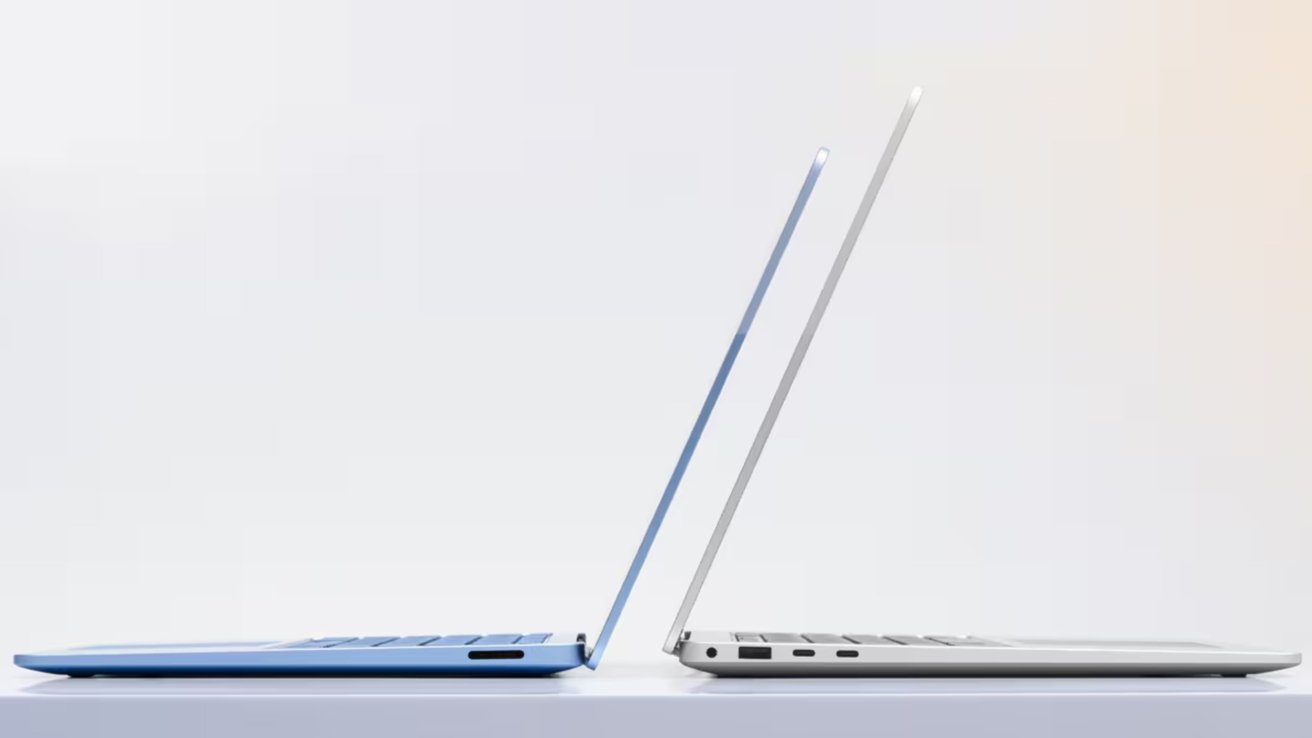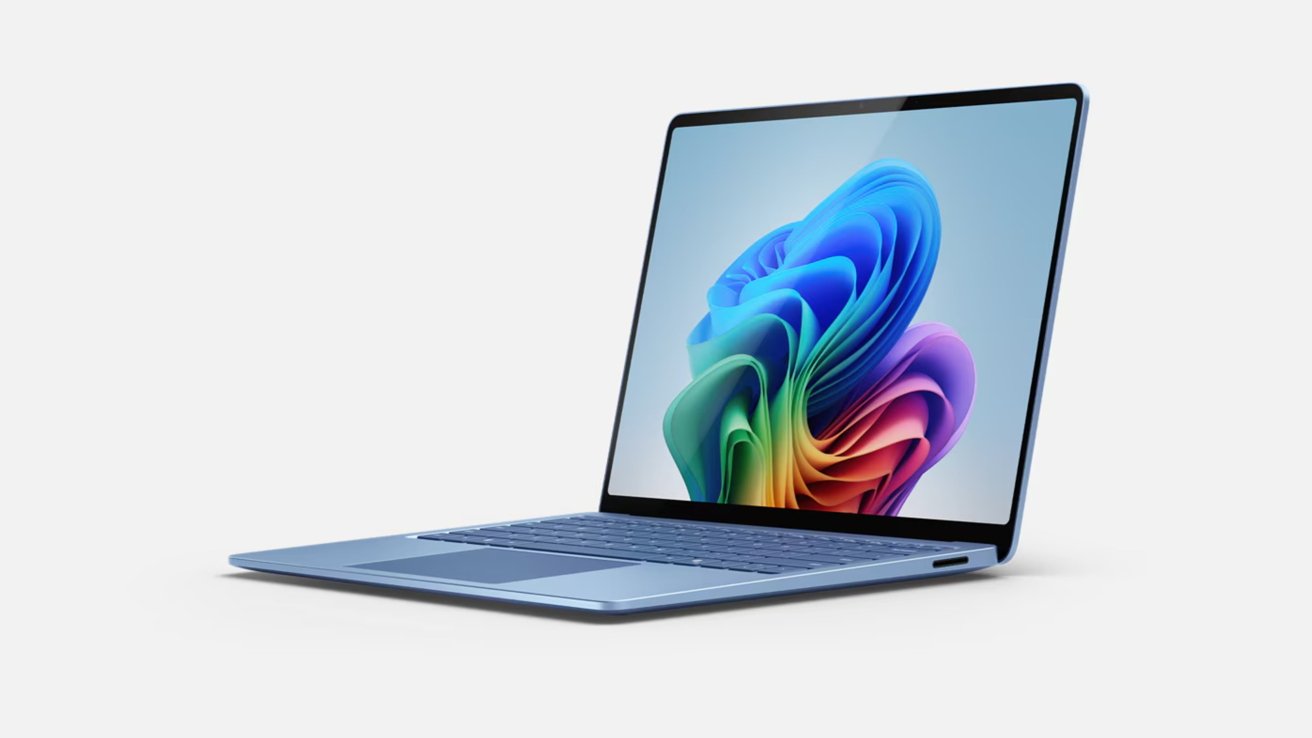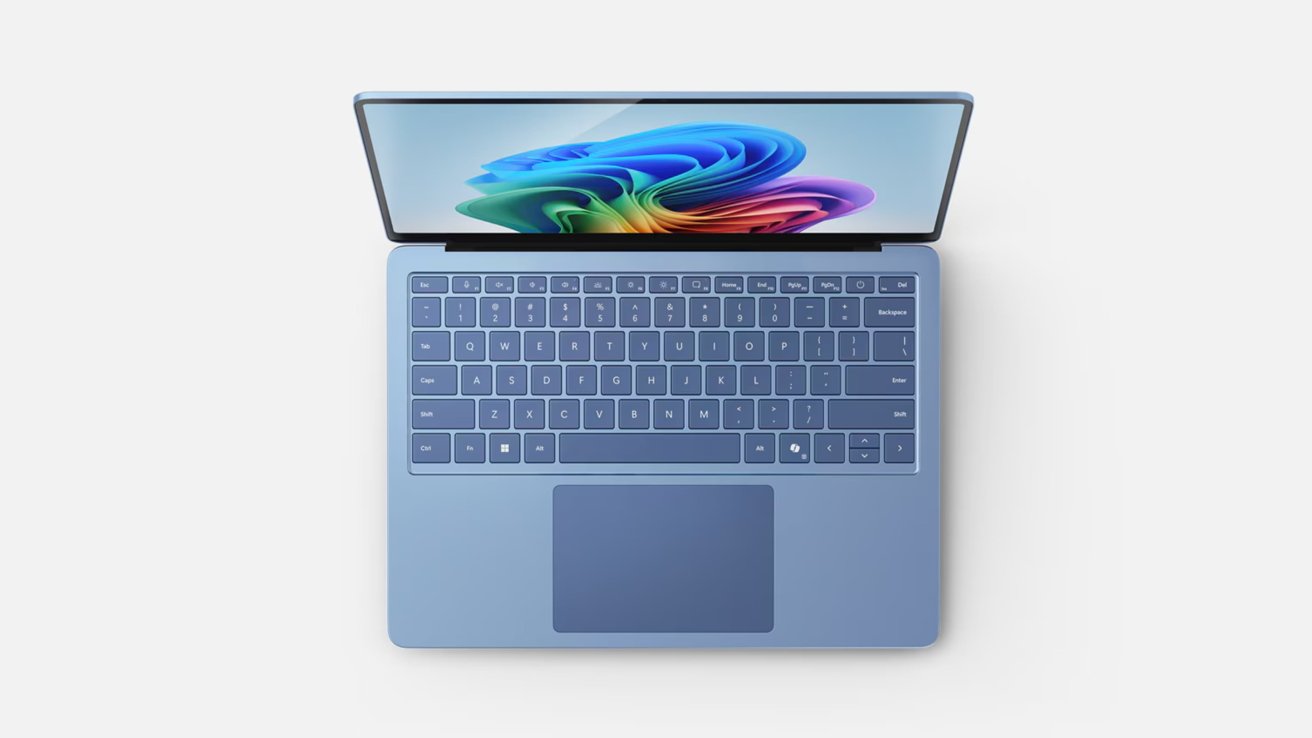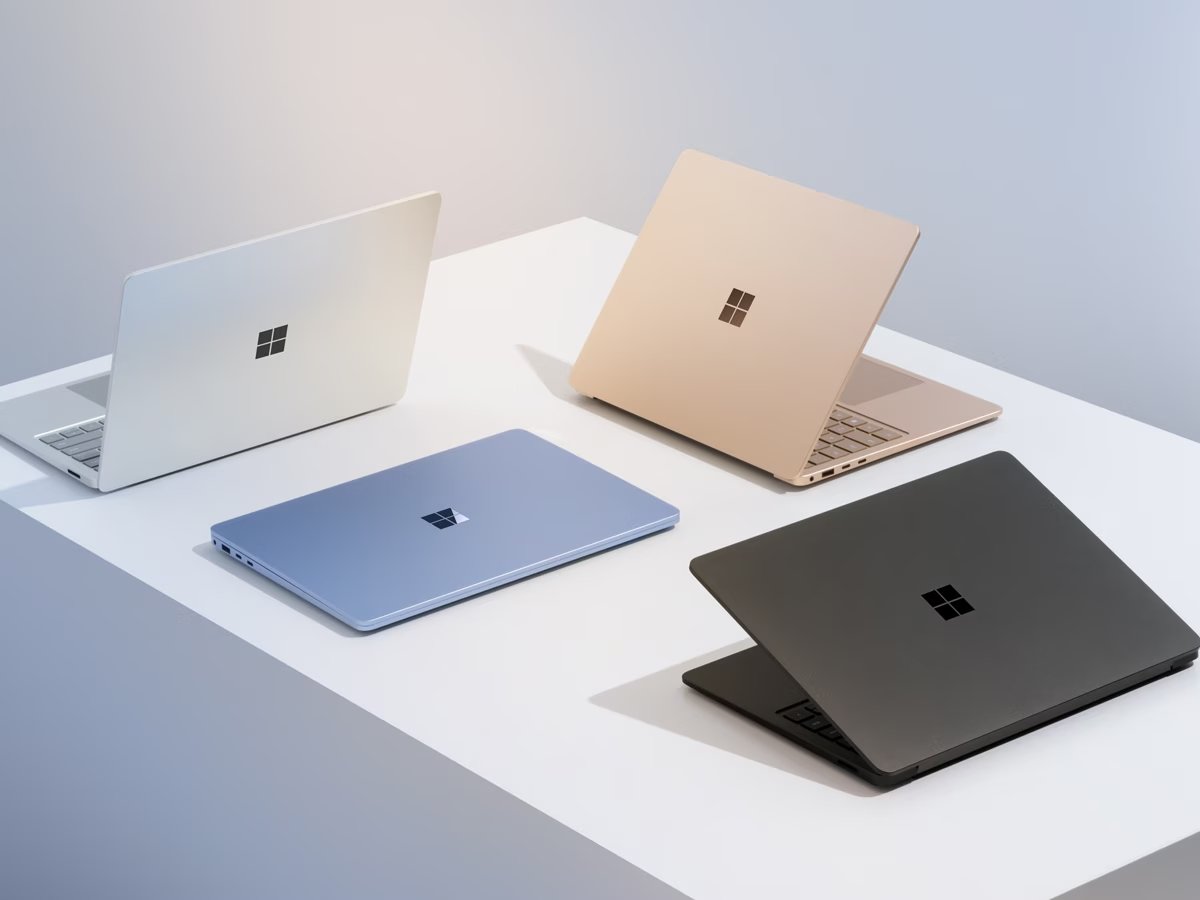AI computer showdown - MacBook Air vs. Microsoft Surface Laptop Copilot+ PC
At launch, Apple said that the M3 MacBook Air is the fastest consumer-grade AI laptop, and Microsoft's has arrived to challenge it. Can Microsoft claim the crown with the Surface Laptop Copilot+?
![Microsoft's Surface Laptop Copilot+PC [left], Apple's MacBook Air [right]](https://photos5.appleinsider.com/gallery/59778-122242-headerimagemslvmba-xl.jpg)
MacBook Air vs Surface Laptop Copilot+
During Microsoft's special event on May 20, the company launched a new set of Windows PCs under the banner "Copilot+ PC." The initiative is to signal to consumers that they can take advantage of AI processing on sleek notebooks.
Given Apple's use of the Neural Engine in its products, this is something the Mac lineup has had for years. First, it was used in its A-series chips for iPhone and iPad, before becoming a core part of its Apple Silicon strategy.
Microsoft's launch included a new Surface Laptop, the more entry-level model in the range. Offered in two sizes, it seems apt to put them against Apple's own entry-level notebook offerings, the MacBook Air.
MacBook Air vs Surface Laptop Copilot+ - Specifications
| Specifications | Apple M3 MacBook Air (2024) | Microsoft Surface Laptop Copilot+ PC |
|---|---|---|
| Starting Price | $1,099 (13-inch), $1,299 (15-inch) Best M3 MacBook Air 13-inch prices Best M3 MacBook Air 15-inch prices | $999.99 (13.8-inch), $1,299.99 (15-inch) Best Surface Laptop prices |
| Dimensions (inches) | 11.97 x 8.46 x 0.44 (13-inch), 13.40 x 9.35 x 0.45 (15-inch) | 11.85 x 8.67 x 0.69 (13.8-inch), 12.96 x 9.41 x 0.72 (15-inch) |
| Weight (pounds) | 2.7 (13-inch), 3.3 (15-inch) | 2.96 (13.8-inch), 3.67 (15-inch) |
| Display | 13.6-inch Liquid Retina, 15.3-inch Liqud Retina Wide Color (P3), True Tone | 13.8-inch PixelSense Flow, 15-inch PixelSense Flow, sRGB and Vivid color profiles, Adaptive color and contrast, 3:2 aspect ratio, 10-point multitouch |
| Resolution | 2,560 x 1,664 (13-inch), 2,880 x 1,864 (15-inch) | 2,304 x 1,536 (13.8-inch), 2,496 x 1,664 (15-inch) |
| Processor | Apple M3 8-core | Snapdragon X Plus (13.8-inch only), Snapdragon X Elite, Qualcomm Hexagon NPU |
| Graphics | 8-core GPU (13-inch only) 10-core GPU | Qualcomm Adreno GPU |
| Memory | 8GB, 16GB, 24GB | 16GB, 32GB |
| Storage | 256GB, 512GB, 1TB, 2TB | 256GB, 512GB, 1TB |
| Battery Life | Up to 18 hours of Apple TV app movie playback | Up to 20 hours of local video playback (13.8-inch), Up to 22 hours (15-inch) |
| Networking | Wi-Fi 6E Bluetooth 5.3 | Wi-Fi 7 Bluetooth 5.4 |
| Biometrics | Touch ID | Windows Hello |
| Camera | 1080p FaceTime HD | 1080p Full HD camera with Windows Hello |
| Audio | Four-speaker sound system (13-inch), Six-speaker sound system (15-inch), Three-mic array with directional beamforming, Voice Isolation and Wide Spectrum mic modes, Headphone jack with high-impedance headphone support, Dolby Atmos support with Spatial Audio | Omnisonic Speakers, Dolby Atmos, Dual Studiotwo Mics with voice focus |
| Ports | Two Thunderbolt/USB 4 ports 3.5mm headphone, MagSafe 3 | Two USB 4 ports, USB-A 3.1, 3.5mm headphone, Surface Connect port, MicroSDXC card reader (15-inch) |
MacBook Air vs Surface Laptop Copilot+ - Physical Dimensions
Made from aluminum, the MacBook Air have shaken off the old wedge-based appearance in favor of one closer to the industrial MacBook Pro. Available in 13-inch and 15-inch varieties, it also offers consumers a choice of screen and physical size.
The new Surface Laptop follows down a similar route in many ways. Constructed from an enclosure made with recycled aluminum alloy, it too fits the flat slab aesthetic, albeit with a little bit of a taper from the back to the front.
Much like the 13-inch and 15-inch varieties of MacBook Air, Microsoft also offers two versions of the Surface Laptop. In this case, it's 13.8 inches and 15 inches.
In terms of footprint, the MacBook Airs are 11.97 by 8.46 inches and 13.40 by 9.35 inches respective of size. Microsoft's offerings are 11.85 by 8.67 inches and 12.96 by 9.41 inches.
Due to Microsoft's chosen aspect ratio of 3.2, this makes Microsoft's screens a little squarer, but the notebooks are pretty similar in overall footprint.

MacBook Air vs Surface Laptop Copilot+ - Microsoft offers two sizes of Surface Laptop: 13.8 inches and 15 inches.
On the thickness side, Apple's notebooks measure 0.44 and 0.45 inches, while the Surface are 0.69 inches for the 13.8-inch model, 0.72 for the 15-inch.
The weights of the notebooks err towards Apple, with its 2.7-pound and 3.3-pound models lighter than Microsoft's 2.96 pounds and 3.67 pounds.
MacBook Air vs Surface Laptop Copilot+ - Display
Apple's displays are Liquid Retina, with 13.6-inch and 15.3-inch measurements and a notch for the camera in the top side. Supporting Wide Color (P3) and True Tone, they also manage to offer 500 nits of brightness.
Microsoft offers PixelSense Flow displays, measuring 13.8 inches and 15 inches. They have sRGB and Vivid color profiles, as well as adaptive color and contrast.
Apple's resolutions are 2,560 by 1,664 and 2,880 by 1,864, depending on the size. Meanwhile Microsoft opts for 2,304 by 1,536 pixels in the 13.8-inch model, 2,496 by 1,664 for the 15-inch.
In terms of pixel density, the MacBook Airs reach 224 pixels per inch, while the Surfaces manage 201ppi.
Apple doesn't say what the contrast ratios are for its displays, but Microsoft claims its Surfaces manage 1,400:1 and 1,300:1, depending on the size. However Microsoft doesn't mention brightness, while Apple says it can manage up to 500 nits.
MacBook Air vs Surface Laptop Copilot+ - Performance
The 13-inch MacBook Air is available with two configurations of M3 chip, with both using an eight-core chip with an even efficiency and performance core split. The difference is in GPU, with a choice of 8-core or 10-core chips, though the 15-inch only offers the 10-core GPU.
There's also Apple's Media Engine, which can handle video encoding and decoding duties, which can speed up some creative workflows.
Then there's the Neural Engine, which continues to be a 16-core component, capable of over 18 trillion operations per second. This element handles all of the machine-learning tasks of apps.
In both models, Microsoft employs the Qualcomm Snapdragon X Elite chipset, with the 13.8-inch also having the X Plus option.
The Snapdragon X Plus has a ten-core Oryon CPU, combined with a Qualcomm Adreno GPU. The Elite version has a 12-core CPU.

The NPU used in the Surface Laptop is double the performance of the M3's Neural Engine.
There's also a Qualcomm Hexagon NPU for neural processing, effectively its version of Apple's Neural Engine. In this case, Microsoft says the Hexagon NPU can run at up to 45 trillion operations per second.
According to Microsoft's marketing, the chips can outperform the 15-inch MacBook Air by up to 58% in "sustained multithreaded performance."
On the memory side, Apple offers 8GB, 16GB, and 24GB capacities of Unified Memory. Microsoft offers 16GB or 32GB of LPDDR5x RAM.
Benchmarks for the 15-inch MacBook Air put it at 2,596 and 9,745 for Geekbench's single-core and multi-core tests respectively.
There are no official benchmarks for Microsoft's new releases, but we can use other benchmarks for the same chip to speculate.
Early benchmarks for the Elite version seem to put single-core scores at between 2,400 and 2,750, comparable to the M3.

MacBook Air vs Surface Laptop Copilot+ - The M3's single-core results versus a range of Snapdragon X Elite results
For multi-core, the results are quite a bit higher, at around 12,000 to 13,900. This makes sense, considering there are more CPU cores at play in Microsoft's notebooks.

MacBook Air vs Surface Laptop Copilot+ - The M3's multi-core results versus a range of Snapdragon X Elite results
There's also the thermal advantage Microsoft has, as the Surface Laptop has a fan. The MacBook Air does not use a fan, so it requires the case itself to handle the thermal management duties.
This would mean that for lengthy, intensive workloads, the MacBook Air will be more liable to throttle. Neither of these models seem intended a market demanding a number of long-term processing loads, though.
MacBook Air vs Surface Laptop Copilot+ - Camera and Audio
The MacBook Airs have notches holding the 1080p FaceTime HD camera. There's no Face ID here as the notch would hint at, but Apple has resisted doing so thus far.
Microsoft includes a 1080p Full HD webcam, though one with Windows Hello support. This is Microsoft's analog to Face ID.
For audio, the MacBook Airs have four-speaker and six-speaker systems, depending on the size, complete with Dolby Atmos support. They also have a three-mic array with directional beamforming, as well as voice isolation and wide spectrum modes.
Microsoft employs "Omnisonic" speakers with Dolby Atmos support. There's also support for Bluetooth LE audio.
Microphone-wise, Microsoft uses dual studio mics with a voice focus.
MacBook Air vs Surface Laptop Copilot+ - Connectivity
The MacBook Air isn't known for its extensive connectivity options, with each having two Thunderbolt/USB 4 ports, as well as a headphone jack and MagSafe 3 connection for charging.
Microsoft's Surface Laptops get two USB 4 ports, as well as one USB-A 3.1 connection, a headphone port, and a Surface Connect port. The 15-inch model also has a MicroSDXC card reader.
Wireless-wise, Apple uses Wi-Fi 6E and Bluetooth 5.3. Microsoft opts for Wi-Fi 7 support and Bluetooth 5.4, though the newer standards may not be that useful this early in their product cycles.
MacBook Air vs Surface Laptop Copilot+ - Battery Life
In terms of capacity, Apple uses a 52.6Wh lithium-polymer battery in the 13-inch models and a 66.5Wh version in the 15-inch editions.
Microsoft says the 13.8-inch model has a 54Wh battery, and a 66Wh in the 15-inch.
Microsoft says its 13.8-inch model can last up to 20 hours for local video playback and up to 13 hours of active web usage. The 15-inch model goes to 22 hours and 15 hours respectively.
Microsoft says both of its MacBook Air models can last for up to 18 hours of Apple TV app movie playback and up to 15 hours of wireless web access.
To recharge the MacBook Air, Apple includes the 13-inch models with the 30W USB-C Power Adapter when configured with the 13-inch display and 8-core GPU, or the 35W Dual USB-C Port Compact Power Adapter for upper-tier models.
Microsoft includes a 39W charger in the 13.8-inch model's box, 65W in the 15-inch.
MacBook Air vs Surface Laptop Copilot+ - Other Features
Both notebooks include backlit keyboards, with Apple using the Magic Keyboard and the Surface using "Moving mechanical keys."
Both also have touchpads, though the Surface's inclusion of 10-point multitouch on the screen is certainly an advantage.

MacBook Air vs Surface Laptop Copilot+ - The keyboard and trackpad of the new Microsoft Surface Laptop.
Biometrics consist of Windows Hello on the Surface Laptop, Touch ID on the MacBook Air.
Storage capacities on the MacBook Air start from 256GB, rising to 512GB, 1TB, and 2TB. The Surface Laptop has 256GB, 512GB, and 1TB capacities, but they are also removable.
MacBook Air vs Surface Laptop Copilot+ - Pricing and Storage
Microsoft's Surface Laptop starts from $999.99 for the 13.8-inch model with Snapdragon X Plus, 16GB of memory, and a 256GB SSD. The cheapest with the Elite version is $1,399.
The 15-inch Surface Laptop starts at $1,299 with the X Elite chip, 16GB of memory, and a 256GB SSD.
The most expensive 13.8-inch model with Snapdragon X Elite, 64GB of memory and a 1TB SSD, costs $2,399. The most expensive 15-inch with the same configuration is $2,499.
The 13-inch MacBook Air starts with the 8-core GPU, 8GB of memory, and 256GB of storage for $1,099. Upgrades to memory cost $200 for 16GB and $400 for 24GB, while the 10-core GPU is available for $100.
The 15-inch starts at $1,299 with the 10-core GPU, 8GB memory, and 256GB storage. The upgrade costs are the same.
Storage upgrades from 256GB include 512GB for $200, 1TB for $400, and 2TB for $800 more.
Surface Laptop vs MacBook Air - An interesting catch-up scenario
Microsoft's Copilot+ PC initiative has been a long time coming, and is something that should help it catch up to what Apple has been doing for years with its own products.
With the ongoing hype of AI reaching fever pitch, this is probably the best time Microsoft could've chosen to do it.

MacBook Air vs Surface Laptop Copilot+ - Assorted Microsoft Surface Laptop colors.
What Microsoft has arrived at with the new Surface Laptop is a great mobile PC. However, it still has to catch up to Apple and its experience with the Neural Engine in its M-series.
That said, Microsoft's use of an NPU with twice the operations-per-second performance wouldn't help. Nor would the increased number of CPU cores.
We could safely say that the new Surface Laptop is in the same sort of ballpark as Apple's MacBook Air in many respects. That even includes price.
But, with a slightly heavier design, a lower-density display, and needing to play catch-up to Apple, Microsoft is not quite where it needs to be.
There's also the fact that this is a bigger shift over towards an ARM chipset than in Microsoft's previous efforts. To end users who may be used to the normal way of using x86 apps, they will have to get used to using ARM and possibly using alternative apps.
This isn't insurmountable, as Microsoft has been on ARM for years, but not in a significant way. Meanwhile Apple's multi-year transition management has been a success, thanks to its Rosetta 2 tool.
Ultimately, the new Surface Laptop is very good, on paper. But the MacBook Air still offers a compelling option if operating systems aren't part of the equation.
MacBook Air vs Surface Laptop Copilot+ - Where to buy
The Surface Laptop Copilot + PC can be ordered from Microsoft directly, as well as Best Buy and B&H Photo. The laptop starts at $999 and tops out at $2,499, the latter price for the 15-inch model with the Snapdragon X Elite, 64GB RAM and a 1TB SSD.
If Apple's MacBook Air is more your style, the latest models are heavily discounted in our M3 MacBook Air 13-inch Price Tracker and M3 MacBook Air 15-inch Price Tracker. At press time, MacBook Air discounts of up to $250 off are at your fingertips.
Read on AppleInsider

Comments
That said, that unfortunately is a harder sell for someone not looking to use macOS post-Intel Macs these days because we no longer have dual boot with Boot Camp, only VMs, but with MS moving further into supporting ARM versions of Windows I hope that comes to M-series Macs again.
Btw I still find touch screen not very usefull - everytime i see the laptops with displays full of fingerprints that make the reading of the screen quite difficult in very bright conditions - no thank you
Personally, I hope they do performance and battery tests with these new Surfaces to the MBAs and MBPs of varying generations.
MacBook Air 15" is $1299 for M3 with 8 GB RAM and 256 GB SSD
MacBook Pro 16" is $2499 for M3 Pro with 18 GB RAM and 512 GB SSD
-
Surface Laptop 13" is $999 for Snapdragon X Plus with 16 GB RAM and 256 GB SSD
Macbook Air 13" is $1099 for M3 with 8 GB RAM and 256 GB SSD
Macbook Pro 14" is $1599 for M3 with 8 GB RAM and 512 GB SSD
Snapdragon X Plus - 45 TOPS (INT8)
Snapdragon X Elite - 45 TOPS (INT8)
Apple M3 - 18 TOPS (FP16)
Apple M4 - 38 TOPS (INT8)
On the footprint side, they have about the planform area, a footprint, but the MBA is over 0.64x as thin as these Surface Laptops. So footprint in a backpack, both the thinness and the weight, would favor Apple. It may not be much of an advantage to most people, and may not really matter. If that is the opinion, say it that way.
These GB numbers, I assume they are GB6 numbers as the Snapdragon ones are GB6, are not for the M3. They appear to the GB6 numbers for the M2 MBA, possibly the 7 core version of the M2 model. The M3 models will have GB6 single core scores of about 3100 and multicore scores of 11000-12000.
The NPU was meant to be a big selling point for this particular chip. Looks like they actually delivered on that claim.
For those confused by this whole new world. A rating of 40 TOPS or higher is generally seen as the benchmark where AI (basic AI) can be processed on device as opposed to needing cloud assistance. Obviously there is a lot more to it, but the marketing seems to match the hype on this occasion.
MS doesn't have to have a trained AI model that only can work at 40 TOPS or more. You will soon see that Co-Pilot can run on a CPU from 4 years ago. How much slower will it be? Nobody knows just yet. What's to stop them from developing an AI model that works on 30 TOPS, or 20 TOPS, or 10 TOPS? Then, doing what? It's all a design choice. Heck, the cycle time of doing a network query to computer on the network somewhere and having the results come back will be quite variable in itself. There's going to be some kind of model that will say this or that question should be done locally or through the network.
Obviously, if it is running on a discrete GPU, it will likely be faster than the Snapdragon NPU. Microsoft or the GPU OEMs will enable it to run on GPUs. It will be interesting to see how Snapdragon versus Intel/Nvidia/AMD system war plays out.
Lastly, it's not clear to me that the M3 TOPS number of 18 INT16 TOPS doesn't equate to 36 INT8 TOPS. If it can't pack 2 INT8s into a INT16 and operate on them simultaneous on the M3, that's a curious design decision. That's usually a cheap freebie.
When the third parties get their hands on the Qualcomm device they will find that the numbers have been massaged by Qualcomm one thing that is telling is the wattage used by the Elite SOC when compared to Apples SOC, the Elite is using nearly four times more watts 80 than both M3 and the new M4 which are beasts when it comes to speed/power and low wattage. 80 watts only looks good when compared to Intel or AMD laptops.
https://www.notebookcheck.net/Apple-M4-SoC-analysis-AMD-Intel-and-Qualcomm-currently-don-t-stand-a-chance.839332.0.html Apple is even using fewer cores less memory and no fan and that is just the M4 in a iPad Pro what happens when the better Apple M4 SOC'S are in a laptop?
Notice the 23 comments in the link most are crying.....
The 23 W version is what's in most devices.
From Anandtech (Oct. 2023)
"Thin and Light" version has a 23W TDP:
It won't be Qualcomm they have no control over the AI part directly however it will be a problem for them going forward because Recall Microsoft is on the case.
https://www.notebookcheck.net/Apple-M4-SoC-analysis-AMD-Intel-and-Qualcomm-currently-don-t-stand-a-chance.839332.0.html